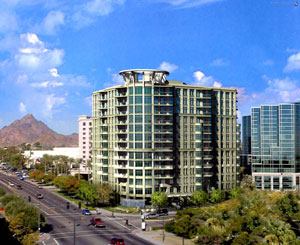An Economy Finds Its Wings A new housing unit is needed for every 2.8 new residents moving to Phoenix, according to economist Elliott D. Pollack of Elliott D. Pollack & Co. For the last nine years, Phoenix ranked second in the nation for population growth among cities. In 2003, the Phoenix-area population grew 3.1 percent to more than 3.3 million residents.
The outlook for job growth, which has a direct impact on population growth, is promising. Possibly the biggest blip on the Phoenix economic horizon is the entrance of biotechnology and biomedicine initiatives. The largest is Translational Genomics Research Institute (TGen), a nonprofit genetic research organization. In June, the city of Phoenix broke ground on a $39 million facility downtown that by the end of this year will house TGen and serve as a magnet for other biotech-related tenants.
Also downtown, the Phoenix Civic Plaza convention center is receiving a $600 million expansion, quadrupling its size. These and other initiatives are expected to generate 55,300 new jobs in 2004 and an economic growth of about 5 percent, according to Pollack. The U.S. Bureau of Labor Statistics reports that the area added 19,000 jobs between September 2002 and September 2003, making Phoenix the third-fastest-growing job market in the nation.
Making Phoenix even more attractive are other factors, such as 360 days per year of sunshine and a business-friendly environment. In addition, the city has a relatively low cost of living, according to the American Chamber of Commerce Research Association, which annually surveys more than 300 urban areas. Usually, cost of living increases as a market grows, but in the case of Phoenix, it decreased from 103.6 percent of the national average in 1993 to 98.5 percent today. By way of contrast, San Francisco is the nation’s third-most expensive city at 181 percent of the U.S. average. Los Angeles is at 147 percent, Chicago is at 131 percent, and Portland, Ore., is at almost 112 percent.
Many Good Places to Land
Because of its size, Phoenix has desirable submarkets to suit investors’ different needs. Many of these areas are being transformed by the Loop 101 and Santan freeways, which are creating access to new land and opening doors for strategic commercial development.
Loop 101 is helping the Northwest Valley become one of the strongest candidates for multifamily investments in greater Phoenix because of its excellent upside potential. This older part of the Valley has carried the stigma of aging class B and C properties. But with the completion of the freeway and aggressive economic development efforts by communities such as Peoria and Glendale, it is rebounding.
Many of Arizona’s top employers are in the Northwest Valley, including the regional offices of Wal-Mart, Wells Fargo, Costco, and Walgreen’s. Glendale also recently became home to the new Phoenix Coyotes hockey arena, and the Arizona Cardinals football stadium is scheduled to be completed there in 2006. Already the stadium has been chosen to host the 2008 Super Bowl, with a predicted $400 million economic impact.
